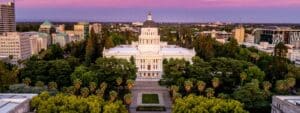Denis Cuff
David Dolhberg, an avid hiker, paddler and bicyclist, sees plenty of reasons to extend an East Bay property tax to acquire and develop regional parks and trails when he notices thegaps in trails along the shoreline and ridges of the Bay.
“If you’re hiking or riding from one park to another, you want the trail links connected, like a jewel on a necklace. We don’t have that yet,” said the Richmond attorney and father of two children. “With more trails, parks and open space, you have a better quality of life.”
But Dan Marciel, a cattle rancher north of Livermore, said 98,000 acres is enough land for the East Bay Regional Park District to have in Contra Costa and Alameda counties.
“We’ve got some nice parks, but there are some times in winter when I hardly see anyone in them,” said Marciel, president of the Alameda County Farm Bureau. “I just don’t see why we need another tax measure for the public to buy more open space.”
Measure WW, an extension of a property tax to raise $500 million to buy and develop parks, has spurred voters in Contra Costa and Alameda counties to focus sharply on a question many urban areas struggle with: How much land should be set aside as open space? When is there enough or not enough?
Both sides agree there is no formula answer. To be sure, Bay Area counties have widely varying amounts of open space — parks or preserves operated by park agencies, water districts, land trusts and homeowners groups.
In the East Bay, the regional park district owns about 9 percent of the 1.4 million acres in the two counties. All together, 24 percent of Contra Costa County and 22 percent of Alameda County is protected open space — close to the 24 percent average for the region, according to a survey by the Bay Area Open Space Council.
About 54 percent of Marin County and 28 percent of Santa Clara County is open space, and 12 percent of Solano County is open space.
“I think 9 percent of the land in Contra Costa and Alameda counties is a huge amount for any single organization to have,” said Ken Hambrick, president of the Alliance of Contra Costa Taxpayers. “It’s enough.”
Park officials, conservationists and an influential business group disagreed, saying the East Bay needs more recreation land for a growing population to hike, jog, picnic, walk dogs, ride mountain bicycles, and commune with nature.
“I’m not sure you can set a formula for open space in an area,” said Linda Best, president of the Contra Costa Council, a voice for businesses. “But as our population continues to grow, it’s important to enhance the regional park system to meet recreation needs.”
Best said the 67 regional parks, preserves, shorelines and wilderness areas are important assets to attract workers to the East Bay. “Some of the value of hiking in these places is that they aren’t crowded,” she said.
Regional park officials said they don’t set out to amass specific acreage amounts, but rather to provide a mix of recreation lands that East Bay residents can reach in a short drive.
Park board members and managers say they also strategically target land purchases to assemble parcels that follow ridges and shorelines, fill in valleys, and provide an access point for visitors.
“It’s not about acquiring land for the numbers, but for the public to enjoy,” said Bob Doyle, a park district assistant general manager. “It’s about providing recreation close to people’s homes.”
Park officials also say they buy land to protect wildlife habitat and travel corridors for hawks, mountain lions and other creatures, including the threatened California red-legged frog.
“Living in a region with 7 million people, it gives me great hope that there are still cougars out there,” said Jeremy Madsen, executive of the Greenbelt Alliance. “Open space acquisitions increasingly are focusing on what it takes to accommodate wildlife.”
About $300 million of the Measure WW bond measure would go toward acquiring land, and the other $200 million goes toward improving regional or city parks, which get grants based on their population.
Hambrick, the anti-tax leader, said it’s wrong for the park system — the largest regional park district in the nation — to ask voters for money to buy more land when the agency hasn’t opened 15,000 of its 98,000 acres to the public. “They’re not opening the land they have.”
Park officials said new purchases can’t be opened overnight. It can take years to find enough contiguous landowners willing to sell the land needed for a new park, officials said.
Builders sometimes contribute land to the park district to offset development impacts, but that usually doesn’t happen until building projects go through land-use reviews.
For example, the park district took 10 years to acquire six different parcels for the 587-acre Dublin Hills Regional Park, which is scheduled to open next year.
“It was very challenging,” said Jim Townsend, the park district trail development program manager. “We had to wait for a long time to acquire a parcel that the public could use for access to the park.”
###




